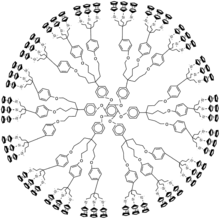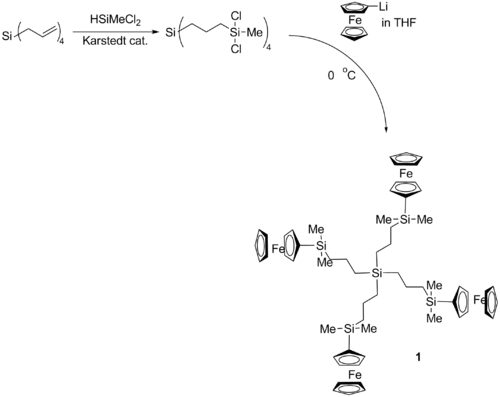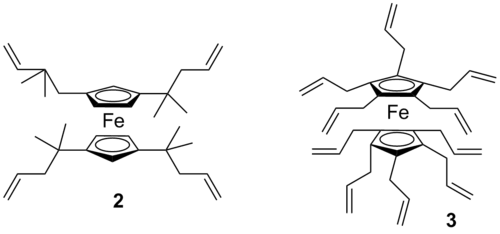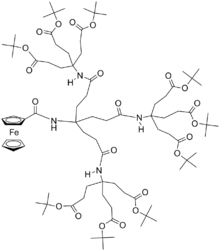Ferrocene-containing dendrimers

Ferrocene-containing dendrimers are of interest for their ability to do multielectron-transfers and they have been synthesized by convergent and divergent approaches. There are three basic categories that ferrocene-containing dendrimers can be placed in: (a) dendrimers with ferrocene cores, (b) dendrimers with peripheral ferrocene groups, and (c) dendrimers with ferrocene at the core and the peripheral.[1]
Synthesis
Ferrocene-containing dendrimers can be synthesized by both convergent and divergent methods. Some of the first dendrimers of this type, were made by attaching ferrocene units to small silicon containing dendrimers.[2]
Dendrimers with peripheral ferrocene groups are usually synthesized by attaching ferrocene to the core by either olefin metathesis or by hydrosilylation reactions.[1] As an example, compound 1 was synthesized by a divergent approach in which tetraallylsilane undergoes Pt-catalyzed hydrosilylation to form the core. This core was then reacted with ferrocenyllithium to form 1.[3] Convergent approaches can also be used to make dendrimers with peripheral ferrocene. As an example, figure 1 shows a 54-ferrocene dendrimer which was synthesized by a fast convergent approach.[4]


Dendrimers with ferrocene cores can be synthesized by first making ferrocene derivatives with functional groups. An example of this would be compounds 2 and 3. These compounds can undergo hydrosilylation reactions to form dendrimers. As an example, decaallylferrocene (3) can undergo hydrosilylation with dimethylferrocenylsilane to form a decaferrocenyl functionalized ferrocene as is shown in figure 2.[1]

Properties and applications

There are many potential applications for ferrocene containing dendrimers. The CV of the 54-ferrocene containing dendrimer in figure 2 gave a single reversible wave.[4] The ferrocenyl moieties on these dendrimers are essentially noninteracting redox centers.[3] Because of this, they could potentially be used as molecular batteries or sensors.[4] There have been some efforts to synthesize dendrimers that behave similar to redox proteins. Asymmetric dendrimers similar to the one in figure 3 have been synthesized and have undergone inclusion complexation by beta-cyclodextrin.[5][6]
See also
References
- 1 2 3 Muller, C. et al., J. Organomet. Chem., 2000, 600, 127-143
- ↑ Hudson, R.D.A, J. Organomet. Chem., 637-639 (2001), 47-69
- 1 2 Alonso B. et al., Chem. Commun., 1994, 2575-2576
- 1 2 3 Nlate, S. et al., "Ferrocenylsilylation of Dendrons: A Fast Convergent Route to Redox-Stable Ferrocene Dendrimers", Chem. Commun., 2000, 417-418
- ↑ Cardona, M. C.; Kaifer, A. E.; "Asymmetric Redox-Active Dendrimers Containing a Ferrocene Subunit. Preparation, Characterization, and Electrochemistry", J. Am. Chem. Soc., 1998, 120 (16), 4023-4024
- ↑ Cardona, M. C. et al.; J. Org. Chem., 2000, 65(6), 1857-1864